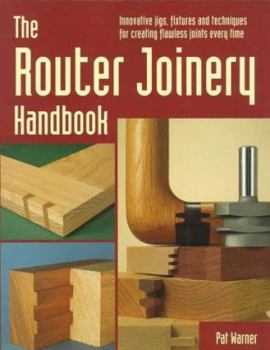The Router Joinery Handbook
Select Format
Select Condition 
Book Overview
Master craftman Pat Warner demonstrates the versatility of the router to create a variety of tight, strong joints-- even for the most complicated projects. Step-by-step instructions are illustrated... This description may be from another edition of this product.
Format:Paperback
Language:English
ISBN:1558704442
ISBN13:9781558704442
Release Date:January 1998
Publisher:Popular Woodworking Books
Length:144 Pages
Weight:1.10 lbs.
Dimensions:0.4" x 8.5" x 11.0"
Customer Reviews
3 ratings
Good, but a bit confusing
Published by Thriftbooks.com User , 15 years ago
The author of this book has been doing router joinery for decades, and he has strong opinions on the appropriate techniques (mounting, jigs, bits, etc.) to be used for making various cuts. I love the basic premise that the book is based on his experience, but I wish he talked more about the WRONG ways to do things so as to put his recommendations in context. (E.g., "It might seem that you could cut this tenon more easily on a router table, but I recommend the use of the free router because...") As it is, you're pretty much left taking it all on faith, and some of the approaches seem needlessly complex. I doubt doubt the advice; I just wish I understood it in more depth. My other gripe with this book is that I've generally had some difficulty understanding how the various jigs and setups work. I'm not speaking existentially - I'm talking about basic details such as "Which of these boards is the workpiece?" and "What's the table and what's the jig?" The photographs, diagrams, and descriptions just aren't sufficiently broken down to make these details clear. To some extent this is probably a question of general woodworking knowledge, and a result of my relatively shallow background. (For example, Warner seems to assume that it's obvious what he means by "the fence" of a jig, even when there are multiple parts of the jig in direct contact with a workpiece. To me it just means "a barrier the workpiece slides against", so that doesn't narrow it down much.) All in all, a meaty and useful book, but be prepared to put some work into decoding it.
Ready for the Next Level?
Published by Thriftbooks.com User , 23 years ago
This is one of those rare woodworking books that combines plenty of great technical information and an inspirational, even challenging, message. Regular readers of magazines like Fine Woodworking and Woodwork know Warner as a highly knowledgeable if occasionally doctrinaire (witness the scorn he heaps upon table-mounted plunge routers!) router maven. Oftentimes such a personality wears thin over the course of a long book; not so with Warner. Having bought the book to learn about a specific jig I had heard about, I found myself reading page after page with attention and growing excitement. My routing (a daily activity in my woodworking business) is going to change for the better thanks to Warner. I'll be building several if not all of the jigs in the book within the next few weeks. I am convinced that, 10 years into my life as a router user, Warner's approach is going to make my work faster, more accurate, and even more enjoyable.Warner's approach is open-eyed and creative. Several of the jigs bring the router to the work in directions (and tool-path-shapes if I may be forgiven a gaucherie) that appear bizarre to someone used to the standard manufactured jigs. Bits in unusual shapes and sizes abound in this book, too. Warner's prose is also occasional eye-openingly unfamiliar, but almost always in a satisfying way. This man has obviously thought long and hard not just about routing, but about how to describe it precisely and without a lot of the hackneyed jargon that often conceals a writer's limited mastery of the subject. I kept coming upon concepts like "handedness" and being reminded of Russian Formalism's "defamiliarization" or "enstrangement." I must share a few cavils about the book. Two of them are about perspective. Every page of the book is full of close-up photos and clear diagrams. However, there is a frustrating lack of wider-angle views. "Okay," I found myself thinking time and again, "Here is a great shot of how this template, this router bit, and the workpiece come together. But how does the whole assembly get held to the bench? Where does the man stand as he moves through the work? And how tall is his workbench?" Leaving aside even such practical matters, it would be nice to see what Warner's shop looks like. A similar claustrophobic feeling permeates the text. Warner seems in such a rush to get us into cutting the joints that we lack a sense of the whole scenario-we don't know what router (or routers), or bits, or jigs we'll be using until they appear without introduction in the process narration. As a matter of fact construction of the key jigs is discussed after their use is described-as if by afterthought....For a simple, even low-tech approach to router jointmaking, I recommend Gary Rogowski's Router Joinery. For those ready to make the step to a more sophisticated and involved, but safer and more accurate approach to the router, this book is a great introduction, and I say again, I am sure that my a
Well written, contains many great router techniques.
Published by Thriftbooks.com User , 24 years ago
Nuances of router operation, router bits, and router use are described which provide important insight that any woodworker needs when using the router. It is the best of several books on routing that I have found. Several jigs for joinery are described that really work well. These jigs and an offset router base have increased my router use and work quality. I recommend this book to everyone, even if you are experienced with the router.





